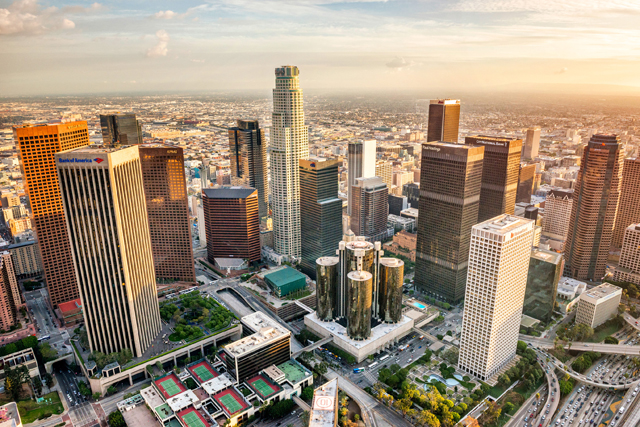
There’s a lot to say about the “City of Angels” known as Los Angeles, California. The second largest city in America, after New York, it is one of the world’s most important hubs for finance, productivity, and most importantly, culture. Often called America’s cultural capital, Los Angeles is home to many artistic ventures that branch out and define the culture at large, but none more so than the industry that was birthed right in it’s own back yard; cinema. Hollywood is used to define the industry as a whole, but it’s name derives from the district of this city in which it was started, making it eternally linked to LA as a whole. The whole reason for the population boom that the city has experienced over the last 100 years is because of the exposure that the film industry has brought to the community, and in some ways, it has grown the city too fast in order to be sustained. Oftentimes, many people immigrate to LA with hopes of making their big break, and soon realize there’s just not enough room for everyone. Even still, it’s a city rich in culture and history, and it’s connection to Hollywood is vital to it’s identity. The city has also served as a backdrop to many classic films, some of which are among the most influential ever made. For this list, I will be looking at the ten movies that best represent the city of Los Angeles, both as a place and as a character within the narrative of it’s story. I will be excluding movies that take place in LA, but remain secluded to a single area; so no Die Hard (1988), since it only shows the area around a single high-rise. I’m also excluding movies like Clueless (1995) and Beverly Hills Cop (1984), because while Beverly Hills is part of the LA area, it is it’s own independent city. They are all fine southland tales, but this is a list about Los Angeles; how unique it is to the rest of the world and how well that is represented by these movies on the big screen. So, with that, let’s take a look at the movies that best represent the place I currently call home, Los Angeles.
10.
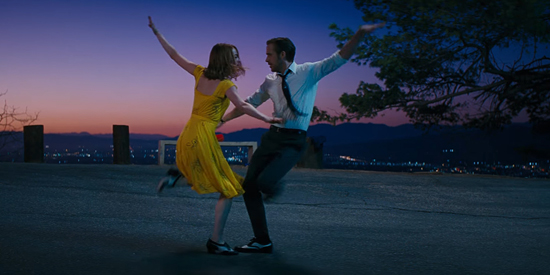
LA LA LAND (2016)
Directed by Damien Chazelle
You just knew that the moment a song and dance number began to break out on a freeway offramp in the middle of a traffic jam that this movie was going to be a love letter to the city. And in many ways it is. Apart from the remarkably staged freeway sequence that opens the movie, the film utilizes many LA landmarks as a backbrop for it’s story; from the backlot of Warner Brothers studio in Burbank, to the Angel’s Flight railway in Downtown, to Grittith Park and the Griffith Observatory. And while the movie does display the majesty of the city in a glorious light, it also at the same time portrays the unfortunate downside to living in LA as well. Namely the way that many people have to give something up of themselves in order to gain a foothold in this city. Whether it’s a person’s free time, their dreams, their personality, or worst of all, their dignity, many artists often come out of LA far less hopeful than when they went in, just because of the unforgiving way that the city works. In the case of the the two main characters played by Ryan Gosling and Emma Stone, what they have to give up is a happy life together in order to pursue the careers they desire and live to their own high standards. It may seem trite compared to some of the harsher realities about Hollywood, but it speaks a lot to the common experience that many would be artists face when they come to LA. This city provides the strongest test possible for a person’s creative motivations, and those who persevere are the one’s who likely did so with leaving their past behind. La La Land provides that medicine amongst the pretty visuals, helping to ground it and feel authentic as a portrait of the city and it’s inhabitants. Also, it provides a great checklist for things to see and do while in LA, as I have also gone exploring throughout the city.
9.
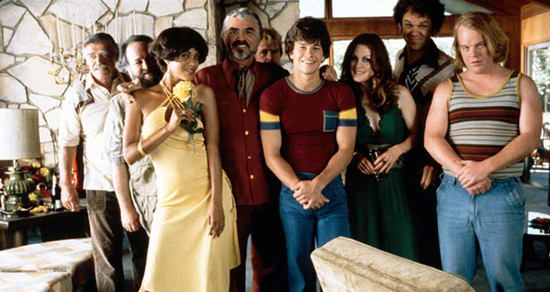
BOOGIE NIGHTS (1997)
Directed by Paul Thomas Anderson
Here we have a different kind of movie that puts the spotlight on another industry that, for better or worse, is also tied to the city of Los Angeles; the porn industry. Showing the rise of pornography in the San Fernando Valley during the free-loving disco era of the 1970’s, the movie Boogie Nights is a magnificent recreation of what Los Angeles was like at the time. It was an era of sleaze and decadence, which ultimately transformed the character of the Southland in a way that you can still see traces of today. Paul Thomas Anderson, who himself was born and raised in the Valley, was no doubt fascinated by the impact that this time period had on the city, and it was something he explored very early on in his movies. Boogie Nights is the first in what you might call his “LA trilogy,” which also included the films Magnolia (1999) and Punch-Drunk Love (2002). Though all three share the Los Angeles (and mostly Valley based) setting, it’s Boogie Nights that really feels like it portrays the city itself as a key part of it’s story. All the different characters we meet, from Mark Wahlberg’s up-and-comer, to Burt Reynold’s domineering auteur, to Heather Graham’s perky Rollergirl, to Julianne Moore’s tortured starlet, all represent some of the kind of people that rose and fell during those turbulent years in the porn industry, and to this day represent some of the characters that you’ll still likely meet in parts of the city; unlucky in some cases. Anderson’s period details are exceptional in this movie, as is the way that he immerses you into a different time in which Los Angeles was very different. You can see this in the spectacular long shots he uses, like the opening shot of a neon theater marquee, or another one showing the different goings on at a pool party. It may not be glamorous, but Anderson certainly makes it fascinating.
8.

COLLATERAL (2004)
Directed by Michael Mann
This may not have been the first Los Angeles based thriller that director Michael Mann had worked on. His 1996 film Heat is rightfully considered a masterpiece of the crime genre, and it makes effective use of parts of Los Angeles for some of it’s most harrowing, action packed moments. But, I feel that the movie he made that is tied more closely to the City of Los Angeles is this more intimate, tension filled piece. Set during a single night in the heart of the city, the story follows a hitman (played by Tom Cruise) who has hijacked a cab driver (played by Jamie Foxx) and is forcing him to drive to every job he needs to complete that night. It’s a fantastic character study, but even more than that, it captures an often unseen element about the city that’s rarely been shown on film before. I find that Collateral is the movie that best represents the feeling of Los Angeles at night. Sure, you have the bright lights of the glitzy neighborhoods that you’ll find in most other cities, but the movie also shows you what nighttime is like outside of those districts. There is this greenish-brown glow that seems to hang over the city at night, fed through the ever present street lamps and vehicle traffic that never stops no matter what time it is. Combine this with a starless sky above, and you’ve got a sense of how eerie and oppressive nighttime in Los Angeles can be. Utilizing digital photography, Mann captured this unique element in his movie and made it an essential part of his narrative. Nothing underlines the dire situation that Foxx’s cab driver is in than the de-saturated colorscape of Los Angeles at night. This one of the most unsung masterpieces of the 2000’s and a movie that really captures not just parts of the city, but the feeling of the city.
7.
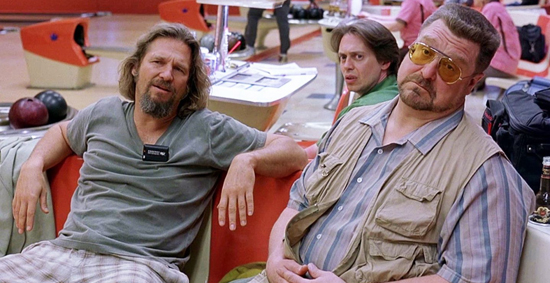
THE BIG LEBOWSKI (1998)
Directed by Joel and Ethan Coen
If you were ever to look for a movie that clearly defined the identity of the quintessential Angelino, it would be The Big Lebowski. This classic farce from the Coen Brothers gives us a hilarious tale centered around the kind of characters that while are not necessarily representations of the city itself, are nevertheless bi-products of it. Jeff “The Dude” Lebowski (played to perfection by Jeff Bridges) is a remnant of the Southland’s brief flirtation with the “flower power” generation, which didn’t take hold the same way like it did up North in San Francisco, so he is left to be a island unto himself in a culture that has left him well behind. But the Coen Brothers use their movie to celebrate this kind of aspect of his character and tie it to the identity of Los Angeles in general. From the iconic view the San Fernando Valley aglow at night, we follow a tumbleweed as it takes us deeper in, until we finally arrive at grocery store where a bearded, bath-robed man is browsing the dairy section for the freshest milk. In these opening minutes, we see the Coen Brother’s intention which is to go from how Los Angeles would like to view itself (the breathtaking glowing metropolis) to showing it’s true face (an old man buying milk). From then one, the Dude is our guide through a Los Angeles seldom seen; with the shabby rows of apartment complexes, to the hole in the wall studios where bizarre excuses for art are made, to of course, the bowling alleys untouched by time. His encounter with the titular Big Lebowski also makes an interesting statement on the wealth gap that also defines much of LA. As the movie states, “The Dude is a man for his time” and that time still illustrates the divide that continues to define the city itself.
6.
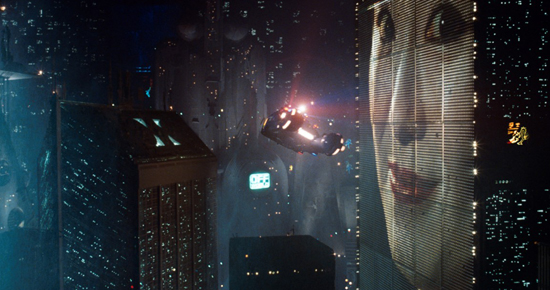
BLADE RUNNER (1982)
Directed by Ridley Scott
This movie represents a view of Los Angeles that never has existed and probably won’t. Considering that we are rapidly approaching the furturistic year of this movie’s setting, 2019, and the city doesn’t look all that dissimilar to how it did 35 years ago when this movie first came out, it’s pretty clear that this is far from the truest representation of Los Angeles on screen. But it does offer another interesting insight into the city’s identity, which is how it once saw it’s trajectory into the future. Back in the early 80’s, Los Angeles was one of the world’s most polluted cities, with smog being a near constant occurrence in the atmosphere. In addition, the constant sprawl of the city continued to spread out, making it appear that Los Angeles was going to see urban growth that would spiral out of control in the near future. That’s why in the movie, Blade Runner, we see this nearly-post-apocalyptic landscape of a city no longer recognizable as it once was. The movie’s influential visuals give us a look at a city that abandoned all identity in order to build bigger and faster in order to accommodate an unforgiving world. Thankfully things haven’t turned out as dire as it did in the movie, and we still have a Los Angeles today that still feels the same, only a little cleaner. But one thing that the movie does portray accurately about the city is it’s melting pot culture. You see this in the market place scenes where Harrison Ford’s Dekard frequents and finds information. And Ridley Scott did manage to work genuine Los Angeles landmarks into his movie, like the iconic Bradbury Building in Downtown, where the film’s memorable climax takes place. While not a representation of reality, Blade Runner still represents a fascinating view of a Los Angeles that could have been as was feared to have eventually become.
5.

BOYZ N THE HOOD (1991)
Directed by John Singleton
Here we have a movie that shows a very often overlooked community in the City of Los Angeles, which is the inner city known as South Central. This was the birthplace of rap music and street art, which have since gone on to become touchstones of the city’s cultural footprint, but South Central and nearby Compton were also where some of the city’s most ruthless street gangs emerged. Movies that depict this part of the city often do so with the wrong intention, or completely miss the point and just end up misrepresenting it. Fresh out of film school John Singleton took it upon himself to tell the story of his Los Angeles from an authentic inner city point-of-view. This isn’t a movie that exploits gang warfare for action set pieces, nor glorifies the life of a gangster. It’s about the struggle of regular people living in this community trying to lead a normal life amongst the threat of gang violence as well as with the oppression of a racially prejudiced police force. The movie follows three young men, played by Cuba Gooding Jr., Morris Chestnut, and Ice Cube as they all struggle to take command of their lives while the harsh realities of the ghetto would keep pulling them back and force them to do things against their best interest. Eventually, some make it out of the cycle, while others fall victim to it, and the movie does a superb job of illuminating the kind of realities that inner city residents must deal with every day. This movie was a revelation for many, and as we would learn, keenly observant. The following year would see a massive riot engulf the city because of outrage over the brutality of the bigoted law enforcement system that went unchecked for far too long. It was shocking to many, but was all too clear to someone like Singleton whose own experience in the city was reflected in the story he told. For him, it was clear that this was the portrayal of Los Angeles that he wanted to share with the world, and it’s movie that rightfully changed a lot of viewpoints and brought another identity to the city as a whole.
4.
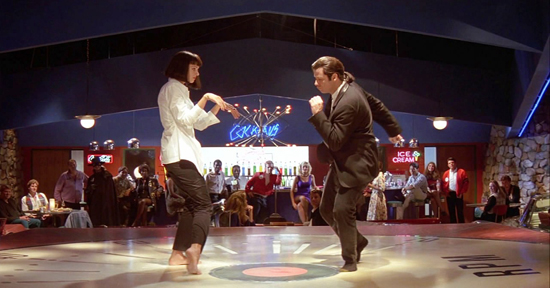
PULP FICTION (1994)
Directed by Quentin Tarantino
Another filmmaker brought up in the City of Angels presenting another unseen side of the city. Quentin Tarantino used LA as the backdrop for a number of movies, including Reservoir Dogs (1991), Jackie Brown (1997), and his upcoming film centered around the Manson Family murders. But it’s Pulp Fiction where he really explores the many different shades of the city, and in particular, the parts that were appealing to him. Tarantino’s style of film-making involves what I would describe as Angelino kitsch. He takes many of the more garish parts of the city, such as the sun-worn stucco, the cramped strip malls on every block, the deteriorating art deco buildings long past their glory, and off course the sports cars that the city was built for. You can see that Tarantino has an affection for this side of Los Angeles because it’s a call back to the type of cinema that he himself was brought up on. During the maverick years of the 70’s, Grindhouse cinema became a lucrative business, and it often involved filmmakers working outside of the luxury of the studios, and instead scrambling out into the city, sometimes into some pretty drab and defunct areas. Quentin wanted to embody that kind of maverick spirit in his own work, and he shows us this beautiful mosaic of a city that thrives on the edge. He also plays around with the image that Los Angeles likes to project to the world, especially in the Jack Rabbit Slims restaurant scene, where Hollywood icons are reduced to novelty dining experience. Tarantino’s portrait of the city may be a bit on the sensational side, but it is reflective of an identity that often hits pretty close to home for Angelinos, which is the rough edges brushing alongside the beautiful sheen of the city, and that’s something that the director is proud to show.
3.
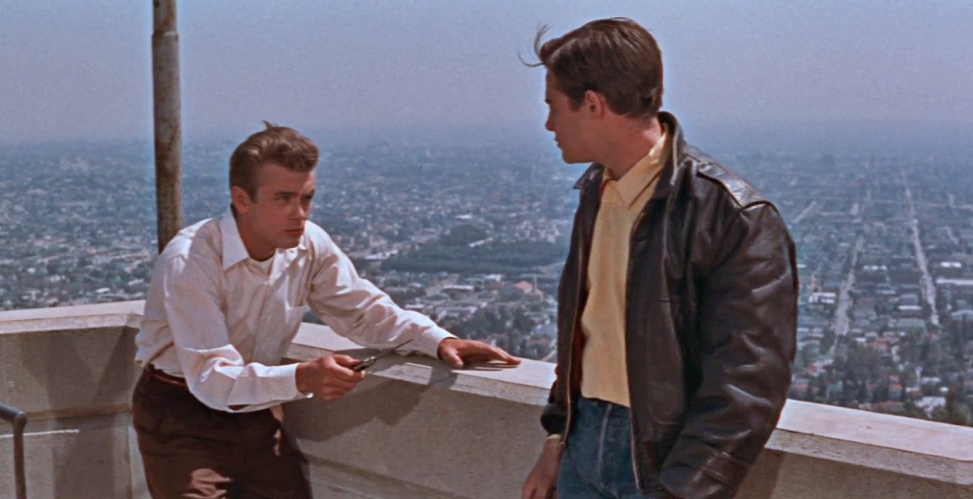
REBEL WITHOUT A CAUSE (1955)
Directed by Nicholas Ray
This widescreen classic from the 1950’s provides a beautiful time capsule of an evolving city that was hitting a turning point. The movie is about several teenagers who are struggling to define themselves in a post-war America that was somewhat still clinging to the past. This is personified most dramatically in James Dean’s career defining role as the titular rebel. He wants to fight against something, but he can’t describe exactly why. For the most part, it’s a struggle against himself that defines his character and what pushes him into a dangerous world of gang fights and street races. The movie perfectly captures that angst of a generation that grew up under the prosperity of their parents but were resentful of the structures and expectations that this prosperity laid upon them. A story like this is perfectly supported by it’s Los Angeles setting, because LA itself was a city going through it’s own growing pains, as sprawl seemed to be engulfing the entire vicinity. Director Nicholas Ray utilized the widescreen process to exceptional effect, capturing Los Angeles landscapes and landmarks in beautiful compositions. The Griffith Observatory in particular is eternally tied to the movie as it provided the setting for some of the movie’s most memorable moments, including the emotional finale. It’s place in Los Angeles history is so profound, that it even received an affectionate homage in La La Land. The city itself also recognized the esteemed place that the movie has and a monument stands today at the Griffith Observatory on the same spot where James Dean filmed the famous knife fight, honoring the tragically short lived actor. To see a fine example of what Los Angeles was like back in a relatively simpler time, this is absolutely the kind of movie you should check out.
2.

SUNSET BOULEVARD (1950)
Directed by Billy Wilder
This movie is not just one of the most searing portraits of Los Angeles in general, but also perhaps the quintessential movie about Hollywood itself. Billy Wilder’s scathing satire about the dark side of showbiz presents an unnerving narrative about how fleeting fame can be and the many different ways that the industry ends up exploiting those who come into it. Taking it’s title from the famous road that passes through Hollywood on it’s way towards the mansion filled hills, the movie focuses on Norma Desmond (Gloria Swanson in a comeback performance), the most delusional of has-beens. In her own words, “I am big. It’s the pictures that got small,” and her belief is that it’s the studios that has kept her away from the world, rather than her own uncompromising, self-interested behavior. In the film, she ensnares a troubled screenwriter (William Holden) looking for a break of his own, and he only becomes wise to the pit that he has dug into when it becomes too late. What Billy Wilder does brilliantly with his movie is to dismantle the glamorous side of Hollywood and show the ugly side underneath. Norma Desmond lives in one of the city’s most extravagant homes (the now demolished Getty Mansion, which was also used in Rebel Without a Cause), but it’s antiquated furnishings and deteriorating state makes it feel almost like a haunted house, and then ultimately a prison. Essentially, we see what fame costs an individual in the end, which is often their dignity, their sanity, and in the screenwriter’s case, his life. That’s the lasting impact of Sunset Boulevard because it makes us aware of the truth that underlies the glitzy falsehoods that the city likes to project.
1.

CHINATOWN (1974)
Directed by Roman Polanski
If there was ever a movie that illustrated the character of a city, this would be it. Chinatown is both a glorious celebration of the visual splendor of the great city of Los Angeles, while also a scathing indictment of the widespread corruption that made it’s expansion possible. The story is a fictionalized account of how the San Fernando Valley was suddenly incorporated into the Los Angeles City Limits, allowing for corporate interests to exploit the precious water supply that fed most of the farmland out there, and do so at a cost to the farmers who were scrapping by, all uncovered by a fearless private eye played by Jack Nicholson. This is the backdrop for the story told by director Roman Polanski and writer Robert Towne. To give their story a unique feel, they drew inspiration from classic film noir of the 40’s and 50’s. It’s actually quite an easy connection to make considering Los Angeles’ surprisingly robust history in film noir. When you look at most classic noirs like Double Indemnity (1944), The Big Sleep (1946), and yes also Sunset Boulevard, they all use LA as their setting, which is unusual because noir is meant to epitomize dark, shadowy subject matter and photography, and LA is quite famous for it’s abundance of sun. But, that rich history lends itself perfectly over to Chinatown, which uses it’s LA setting to beautiful effect. The colors in particular are perfectly saturated to give this movie a by gone era look, despite the the fact that it’s subject matter is decidedly modern. It’s that beauty found in the collision between the glamour and the savagery of Los Angeles that makes Chinatown the quintessential Southland tale. You’ll never find a better movie that presents the duality of a complex city quite as well as this one does.
So, as you can see from this list, the thing that defines Los Angeles is it’s many contradictions. It’s a city full of glamour and rich culture, but also one with a dark edge to it too. Certainly it’s defining feature is the film industry, which continues to fuel the massive wealth that the city enjoys, but the city is also one struggling to deal with the costs of it’s own rapid growth. That’s what makes the movies on this list so distinguished, because they all capture the essence of this multi-faceted city that has many different sides to it. You see the colorful but less glamorous side of the city portrayed in The Big Lebowski, Pulp Fiction, and Boogie Nights, while La La Land and Sunset Boulevard show off the glamour but illustrate the toll that it takes on the people. And then there’s a valuable movie like Boyz N The Hood, which brought a much needed voice to a segment of the city that had long been marginalized. I myself see the many different shades of Los Angeles in my own life. I live outside the heart of Hollywood, making my home in the Valley where it can be comfortable, but far from glamorous. I don’t go to extravagant parties in opulent mansions or eat in the swankiest of restaurants. But, I am only a stone’s throw away from some of the world’s most famous and extravagant movie palaces as well as near many of the landmarks seen in these movies. I have strolled through Griffith Park, walked through the front doors of the Griffith Observatory, and have bowled on the lanes as the Dude. While Los Angeles can be a tough place, I am still happy to call it home, and these 10 movies all illustrate the many reasons why I love it so much. It’s only fitting that the industry it helped foster would reflect back and show the character of this one-of-a-kind city to the rest of the world.